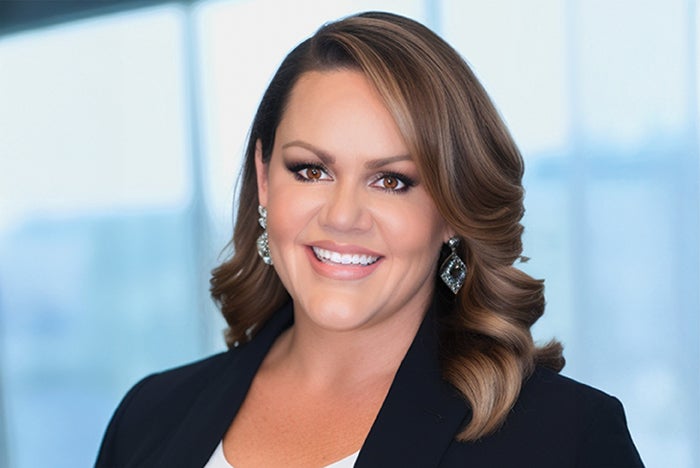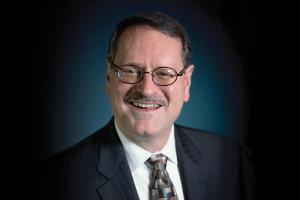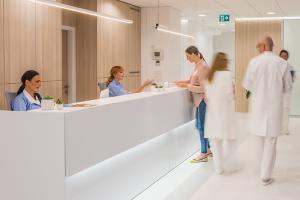New ASHE director engages member voice

The Fissori File
CV
- Principal consultant at ON3 Consulting in Chicago.
- Regional vice president at Teach For America in Greater Chicago-Northwest Indiana.
- Resident principal at Chicago Public Schools.
Accomplishments
- Awarded 2013 Harvard Leadership Fellowship.
- Selected for 2014 Chicago Leadership Collaborative.
Education
- Master of Education from Harvard University in Cambridge, Mass.
- Graduate certificate in special education at Lewis University in Romeoville, Ill.
- Bachelor of Arts in education and counseling at Trinity Bible College in Ellendale, N.D.
Christina Fissori, Ed.M., brings a wealth of professional experience to her role as the American Society for Health Care Engineering’s (ASHE’s) new director of Member Engagement. She expounds on her previous roles and how they have helped to define her leadership philosophy and what she sees for ASHE’s future.
How has your career experience in education prepared you for this role?
For the past 20 years, as a school leader, nonprofit executive and consultant, my career has been driven by a singular mission: unlock confidence in people and unleash leadership within organizations. From classroom teacher to regional executive, I’ve had immense success leading people, strategy and innovation. Still, when I think about what has shaped my approach to this role at ASHE, I think of three specific experiences: my engagement with a professional organization, my graduate research focus and my success leading at a member-driven organization for educators.
As I’ve stepped into the director of member engagement role at ASHE, I’ve had many members share personal stories about how powerful ASHE has been in their careers. It reminded me of one of the most transformative moments in my career. I was teaching at an alternative high school and feeling isolated as I navigated my role’s unique and complex challenges. In my search for professional connections, I found Teach For America (TFA). At TFA, I found a connected network, a driving mission, incredible leadership development and key opportunities to accelerate my career. What I experienced at TFA raised the bar for what professional organizations can be.
Both education and health care are complex sectors, requiring strategic leadership. I spent the past decade leading strategy, people and programs for a national education nonprofit with 70,000-plus members and alumni. My work as regional vice president in the Greater Chicago-Northwest Indiana region shaped my expertise in leading dynamic, high-stakes environments. ASHE operates within a similarly complex ecosystem, and I’m excited to bring my experience bridging competing interests, aligning diverse voices and innovating within constraints to member engagement.
One of the key values that I bring to ASHE is the belief that solutions to systemic problems must center on those most proximate to the challenges. In my graduate research at Harvard University, I focused on systems leadership and the neuroscience of change. Effective change requires leaders to balance equal parts innovation and belonging while building a coalition among those most proximate to the work. In joining ASHE, I am thinking about the intersection between belonging and innovation as I drive toward our mission to optimize the health care physical environment. I find myself obsessed with the same questions that drove much of my strategic leadership in education and am continually asking, “Who does this impact? How do I co-create solutions with them? How do we create belonging for them? And, ultimately, how do we help them see themselves as owners and leaders?” When people feel like they belong and that their voice and expertise are valued, they invest deeply in their own growth and the success of their peers and profession.
How does your team plan to improve member engagement?
I’ve spent time listening to members — gathering insight into their challenges, hearing the day-to-day realities of their roles and understanding their needs and wants. During a recent meeting, one member asked, “What would make your ASHE membership indispensable?” I now ask this question in almost every meeting, and the responses are helping shape and align a strategic focus for my team.
We’ve identified a few key opportunities. First is optimizing internal systems to create a more seamless member experience. From ensuring our communication and engagement pathways are streamlined to optimizing our billing processes, small operational shifts can have a big positive impact.
Secondly, ASHE offers incredible benefits, from industry-leading education and certification programs to networking and advocacy. However, sometimes members are not fully aware of the breadth of benefits and resources available. My team is working to clarify and amplify ASHE’s value proposition, making it easier for members to see how we can help them succeed in their roles and careers. We are enhancing member touchpoints by creating more personalized engagement opportunities and expanding opportunities for members to connect at every career stage.
As we look toward optimizing member experience, we are looking at revamping or building pathways for involvement. This includes expanding leadership and volunteer opportunities to encourage members to take active roles in shaping ASHE’s future, strengthening career development pipelines to attract talent and support members throughout their professional journeys, and deepening chapter engagement by fostering stronger collaborations and resource-sharing at the local level.
What other initiatives is ASHE working to expand and improve upon?
One of the most exciting opportunities for 2025 is developing clear career pathways that attract and develop a diverse talent pool for health care facilities management. Before joining ASHE, I spent decades working with young people, many of whom were researching career options. Yet I had no idea that health care facilities management was an option. This realization reinforces a significant opportunity to ensure the next generation has access to these career paths.
To achieve this, the team is exploring a few avenues. For early-career pipeline development, we’re exploring ways to connect with students, educators and career development programs to introduce them to this viable and rewarding career path. We also will focus on professional development and mentorship by expanding opportunities for members to grow, network and step into leadership through targeted mentorship and training programs. Another avenue is through strategic chapter collaboration. Our 54 ASHE Chapters play a vital role in providing local connections and context. Strengthening this bidirectional relationship between ASHE and its Chapters will ensure members at every stage of their careers find value in our network.
What advice do you have for members who want to be more involved in ASHE but don’t know where to start?
I’d love to take this moment to speak directly to ASHE members: Your success is ASHE’s success. Your involvement is both the drive and purpose of our professional organization. Before getting involved, it’s essential for each of you to understand that you are ASHE. Your voice. Your expertise. Your perspective. Your passion. You are what makes and sustains ASHE.
Here are the steps for those members who are ready to take action: Be intentional. Engagement doesn’t have to be all or nothing, but it should be thoughtful and aligned with your strengths. Attend an ASHE event or conference. In-person and virtual events are great ways to connect with peers and gain useful insights. Also, start volunteering. ASHE offers many opportunities to get involved, from short-term projects and task forces to committees and leadership roles. Every contribution matters. And be sure to connect with me. The best part of this job is connecting with the members. Please reach out, and together, let’s find ways to make your ASHE experience all that you want it to be.
The best professional decisions I’ve made always started with just one step. You don’t have to wait for the perfect moment to step up. Just start.
Jamie Morgan is senior editor at Health Facilities Management magazine.




